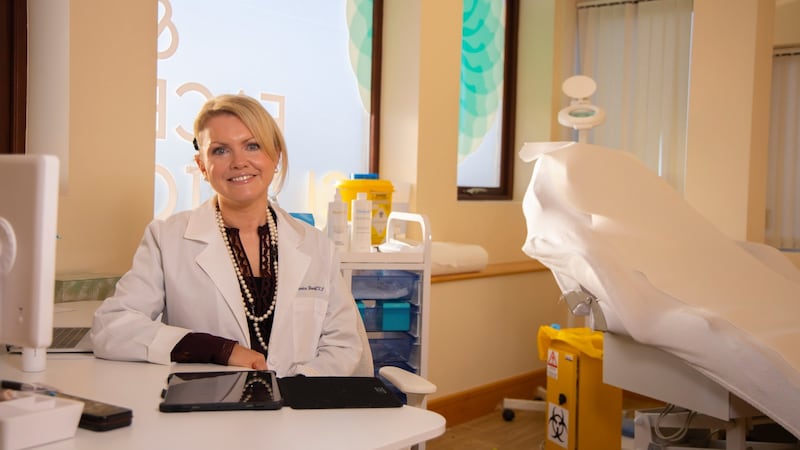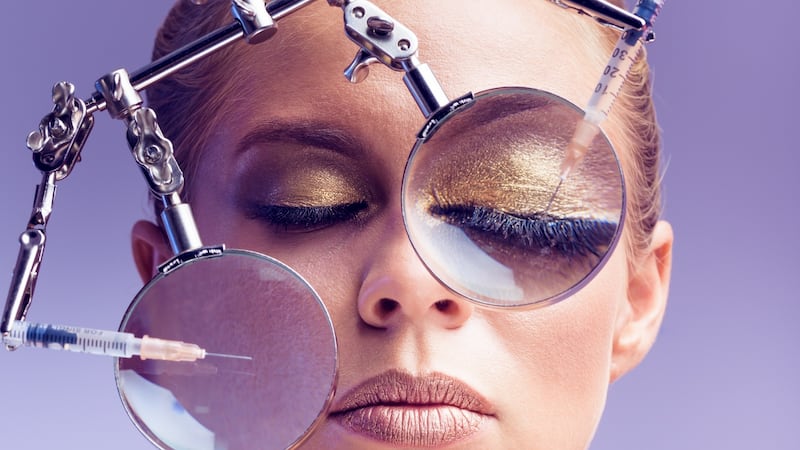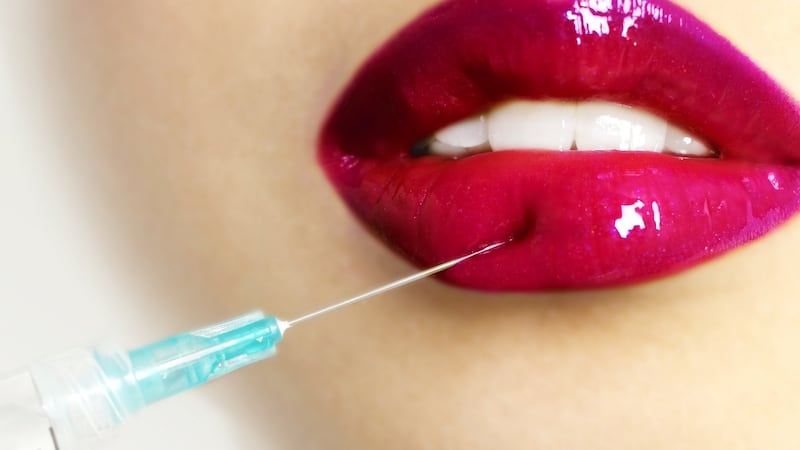“Lip fillers. 0.5ml €90. 1ml €160.” “Beautiful lip shaping done by our cosmetologist.” “Recreate yourself in one appointment.”
An online search for “dermal fillers” reveals what was once an expensive treatment primarily associated with the Kardashians and Love Island contestants is now decidedly mainstream.
Facebook offers a booming marketplace in online fillers: lip fillers, under-eye fillers, chin implants, nose fillers or so-called non-surgical rhinoplasties. "Problem areas" you might not even know you had can be addressed with a quick shot of injectable hyaluronic acid gel – now the standard – in a clinic, beauty salon or nail bar for not much more than the cost of a night out: nasolabial lines, "marionette lines" (also known as smile lines), jawline and tear troughs. The providers are not often doctors or nurses, but "cosmetologists", "lips procedures experts" or a "qualified lip tech". Some don't have a clinic, instead travelling to pop-up clinics in different parts of the country.
Having these tight, puffed, enlarged lips is like a fashion statement, almost like carrying whatever the coolest bag is
Among all the Black Friday deals and pre-Christmas offers, there is little talk of the risks involved. Part of the reason for the explosion in popularity of treatments is that, unlike Botox, anyone can inject dermal filler, and it’s never been easier to come by. Most companies will supply it only to qualified medics but there are Facebook pages, websites and AliBaba listings allowing anyone with a credit card to buy vials of filler direct from a supplier with the intention – presumably – of using them on themselves. Needless to say, this is not advisable.
The boom in fillers worries qualified dermatologists and plastic surgeons, who warn that they’re being marketed as a procedure similar to gel nails or a spray tan with little awareness of the risks. But we’ll come back to that.
According to a recent report, the global market in dermal fillers is worth an estimated €4.4 billion currently, and expected to grow to €8.3 billion by 2028. Most face and lip fillers – or dermal fillers – contain injectable hyaluronic acid, a substance which is found naturally throughout the body, with the highest concentrations in joints, eyes and skin. In the skin, hyalauronic acid attracts water, leading to a plumping effect which smooths out lines and wrinkles and adds volume. The impact typically wears off after six months or more.
You don’t need to go online to see the treatment’s explosion in popularity among a younger demographic who are yet to show visible signs of ageing. Having extensive cosmetic procedures has become so normalised that, in some corners of social media, an untouched human face now looks oddly out of place. The Facebook ads are invariably accompanied by before and after shots. The before shots are mostly women and girls, including some very young teenagers. Though many have obviously had treatments before, they represent a cross-section of humanity, with facial features coming in all shapes and sizes.
They're human beings but they're sort of blending into each other. They're morphing into each other
The after images are extraordinary. They frequently show exaggerated, cartoonish pouts which look, to the untrained eye, like they might belong to someone in the midst of a severe allergic reaction. “Babydoll lips” read the approving captions, sometimes abbreviated to “BBDL”. Or “Russian lips”. Scroll through them at speed and a striking uniformity starts to emerge. The artificial lashes; the heavy, arched brows; the plump cheeks; the punctuation mark of a sharp chin; lips like bolster cushions. Having the same face as your friends has almost become a trend.
"Having these tight, puffed, enlarged lips is like a fashion statement, almost like carrying whatever the coolest bag is – like the Michael Kors bag or the Gucci bag of our generation," says dermatologist Prof Caitríona Ryan of the Institute of Dermatologists.
Dr Janice Brady is a consultant ophthalmic surgeon, who later trained in oculoplastics and now offers aesthetic treatments as part of the services at her clinic in Waterford. She describes noticing a growth in "what I would regard as a distorted view of beauty" on social media sites such as Instagram.
“Girls with incredibly sharp jaw angles which, for most women, don’t look particularly harmonious with the face. Generous lips, which can work well on some faces, but again, would not be a norm for most people. Arched brows – there’s a big trend for the so-called ‘fox brow’. And finally, razor sharp cheekbones.”

Researching this story, I start to notice something odd. The more of these faces I see over the course of a few days, the less extraordinary they look. I'm suffering from a mild manifestation of what Dr Steven Harris, who runs the Dr Harris Clinic in London and describes himself as one of the UK's largest single users of Botox and fillers, calls "perception drift – when your baseline for normal keeps shifting with repeated procedures".
He characterises the overall effect as a process of “alienisation”. “They’re human beings but they’re sort of blending into each other. They’re morphing into each other.”
Every age has its own aesthetic, points out Dr Siún Murphy, a consultant plastic surgeon at the Blackrock Clinic in Dublin. In the 1990s, pre-Wonderbra, the look most commonly aspired to was more androgynous and athletic – and among many of the women of that generation, that remains the desirable profile.
“I would definitely be taking out much more breast implants now than I would be putting in,” she says. “I can truthfully say I’ve never had a patient walk into my practice looking for what’s known as Brazilian butt [lift], which are a notoriously high-risk procedure.”
In my normalisation clinic I treat up to five a day, typically younger patients in their 20s
But among a younger cohort, the norm is a curvier profile with exaggerated facial features. "It has become very voluptuous, and almost Jessica Rabbit-like: the Kim Kardashian, the tiny waist, the massive breasts, the big lips, the high cheekbones. And it's a very 'done' look. There's nothing wrong with that." It's healthy and normal that aesthetics shift and change with the generations, she says.
In many ways, too, a curvier look is healthier than the so-called heroin chic of the 1990s. “It’s when we translate that into a medical realm that is unsafe that we’ve a problem,” says Dr Murphy.
The psychology behind perception drift is really interesting, says Prof Ryan. “It’s been shown that if you show a group of 20 people photos of lips, and ask what they consider an aesthetically ideal lip, they’ll pick out somewhere in the middle ground to begin with. And then if you show them pages and pages and pages of people with larger lips” and then return to the images they saw at the beginning, “they’ll choose a larger lip. So, you know, if you’re scrolling through Instagram all day and seeing image after image of these women with larger lips, then you start to look in the mirror at your own lips and think they look tiny.”
She worries about the impact on younger women, especially of these images being “pushed on our teenage girls and younger women. I think it’s really frightening. It’s a huge thing that needs to be addressed.”
There are clear physical risks to the profusion of cosmetic procedures, says Dr Harris. “But we’re just starting to really understand and study the psychological risks” or the “gateway effect”. After one procedure, “you’ll often start on a journey of changing your other features too”.
Lips, Dr Harris says, are “where things really go wrong because lips require a very in-depth understanding of anatomy, alongside artistry. And there is a lack of both in our industry.”

A busy part of his clinic is what he calls “a normalisation clinic, where I basically reverse features done elsewhere with fillers and restore normality. I treat up to five a day, typically younger patients in their 20s.”
How do they present? “They present looking deformed. They come in and they’ve got all these alien features. They come in either because they can see it themselves... or because they’re getting comments from others.”
Sometimes women contact him straight after a procedure that went wrong. “Or they could present months or years, even many years, later and say that they want their procedures reversed. You can also get something called filler spread, or filler migration, which is where the filler spreads or shifts from its intended location. And that typically happens with overfilling.”
In Dublin, most of Prof Ryan’s clients are 35 and older. But she has also experienced a growing number of requests for normalisation procedures among younger women. “People have come in having been told by somebody that they look overdone, or they look fake or whatever else, and we just dissolve the filler.” Similarly, she adds, she has patients who “arrive and they start pointing out lines and crevices, and they are pumped up like a balloon”. In that case, “I will be completely honest with them and say, actually, I think you’re overfilled and I think we need to just take all of this out.”
Though most of Dr Brady’s clients in Waterford are in the same age bracket and generally just hoping to look less tired, she has noticed that online and in real life, some younger women “will talk very casually about getting 3ml or 4ml of filler like it’s a status symbol. If I do a lip enhancement, the maximum that I use would be 1ml.”
If you put such a large amount of filler into lips, “it’s going to migrate. And it’s going to give you an unnatural appearance into the area above the vermilion border between the nose” and the lip. It “becomes swollen, or it can migrate backwards into the mucosa [membrane]”.
On the private Facebook groups set up for people who have had bad experiences with fillers, there are plenty of examples of this. “I was laughed at in the street and all! It’s been 10 months they are only starting to go down now!” writes one young woman of her experience at a clinic in the east of the country.
“I had to get my lip drained over her,” writes another. “She is a nightmare.”
“I believe a lip lift could work for me since my upper lip is getting smaller and smaller since the filler is disappearing, but the space between my lips and nose is just looking bigger from all the fillers that migrated there,” writes one distressed young woman who has an obvious large protrusion on the area above her upper lip in a Facebook group.
Women distressed by their asymmetrical or lumpy lips or even hypersensitivity reactions are, however, not the worst that can go wrong
One woman in her 40s, whom we’ll call Emma, told The Irish Times how she availed of an offer a few years ago to act as a “model” on a training course for qualified medical professionals, including dentists and dental nurses, learning how to use dermal filler. “It was about €3,000 worth of fillers” and there would be no charge. “I’ve always been open minded about interventions,” so she was delighted at the chance to participate.
When she got there, she was given a consent form to sign, before having filler injected into areas above her eyes, her laughter lines the sides of her nose, and her lips.
The results were discreet as she had been promised. It wasn’t until four months later that things went wrong. “I started to get lumps over on the left hand side of my eyes, and then above my eyebrows. Initially, I didn’t connect the dots at all. And then my eye starts to bruise like I had a black eye, and then it came down onto the lip area, and basically slowly travelled across my face.”
She contacted the company which administered the injectables, but got back an email telling her – as she puts it – “you signed a waiver, sorry we can’t help, regards. I felt like a piece of meat after that.”
After several trips to the GP for antibiotics, which had no impact, she concluded she must be suffering from a rare delayed onset hypersensitivity reaction, possibly triggered by separate auto-immune issues that she suffers from. A course of steroids from her GP eventually cleared it up. But she’s still angry about how she was treated by the company, and the fact that it hadn’t warned her about the possibility of a reaction due to her auto-immune condition.
Women distressed by their asymmetrical or lumpy lips or even hypersensitivity reactions are, however, not the worst that can go wrong. Not remotely.

Prof Ryan and a colleague wrote to the then minister for health Simon Harris in 2019 to highlight their concerns in this area after "we became aware of courses that were being advertised online in Ireland".
Geared towards beauticians, “it was a weekend course on how to inject fillers – particularly lip fillers”. The marketing materials spelled out “how it would dramatically boost their revenue. It was being touted as another beauty technique. And any of us – dermatologists and plastic surgeons who are trained in the area” are aware of “the actual complications that can occur if fillers are injected in the wrong way”.
She gives one example. “The big thing is if filler was injected into a blood vessel, it can block off the blood supply to a whole area that blood vessel supplied.” The area will be affected by “death of the tissue, ulceration. It can be incredibly disfiguring. More dangerous again is if you block a blood vessel going into the eye. That could cause blindness. It’s rare, [but] it can happen.”
Used properly, fillers are safe and "have a great role", says Dr Murphy. "They're super. But you can buy filler as a device; it's not a medicine. So Joe Bloggs can walk into a supplier and buy it online because it's not prescription based."
As things stand legally, these practitioners are doing nothing wrong, whether they’re offering fillers in a clinic or someone’s front room. Currently, unlike Botox, dermal filler is treated under Irish and EU law as a medical device. “It’s not that what anyone is doing is illegal. It’s just that it’s very unsafe,” says Prof Ryan.
The cosmetic industry is “a free for all”, Dr Murphy adds. “And it’s all fine when it’s fine. But if you inject that substrate hyaluronic acid in the wrong place – and we’re talking fractions of millimetres” you’re in trouble and you need a prescription-only product to remedy it.
I'm an experienced dermatologist, and I would not inject my own filler into my own face
The other issue is the brisk, grey market trade in fillers. Fillers trading under the brand names Singfiller and Aqua Secret were available on AliBaba last week for as little as $25 (€22), depending on the quantity ordered.
“[Name redacted] helped me with everything, I recommend getting fillers from a professional first before doing them yourself,” goes one alarming review.
Prof Ryan has little doubt that these grey market products are making their way onto the Irish market. Indeed, the Health Products Regulatory Authority (HPRA) has issued several warnings about fake CE labels on products in recent years.
“When I look at what our fillers cost for us to buy” from companies which offer a clear supply chain from source, and “when I see what some places are charging... What they’re charging is far less than what the cost of a filler should be,” Prof Ryan says. At most clinics, fillers cost upwards of €300-€350. Online, treatments are available for as little as €90.
When patients come to Prof Ryan with botched treatments, “I’ll always ask them to go back to the salon or the clinic and find out what was injected. And sometimes they won’t give them that information” or they can’t make contact with the person who injected them.
Prof Ryan cites the example of a man who contacted her a few years ago. His wife had sourced filler online and injected it in her own cheek. “That’s how accessible it is. And that’s just dangerous to me. I’m an experienced dermatologist, and I would not inject my own filler into my own face.”

Nothing has changed in practice since she wrote to Mr Harris, says Prof Ryan, except that fillers have become more commonplace. The Department of Health issued The Irish Times with a statement which points out that the "medical devices regulation (MDR)", which became fully applicable in May of this year, "will specifically include all dermal fillers... within the scope of that legislation once the technical requirements for these products are in place".
But while this sounds promising, it relates only to pre-market assessment of these products to ensure they get a CE mark. The statement pointed out that the HPRA monitors the safety of medical devices in Ireland after they are placed on the market. What the MDR will not regulate is the "use in practice or administration of the product, location of use, specific training or the qualifications of the individual... Further consideration by the Department of Health may be required in this regard in the future."
Separately, the Patient Safety (Licensing) Bill will introduce a licensing scheme and will “initially include cosmetic surgery services. Research has been and will be carried out in this area to ensure that an appropriate list of high-risk designated activities are identified for inclusion.”
The obvious solution to make the injectable environment safer, say both Prof Ryan and Dr Murphy, is that products like fillers should be made prescription only and recognised as “not a device, but a medicine”, says Dr Murphy.
If the filler goes into a blood vessel, “the only thing that will reverse that if you spot it, because it can happen within minutes, is only available on prescription. So people who have access to the fillers are not qualified doctors. They’ve got it off prescription because they don’t need a prescription to get it. But if you’re in trouble, you need a prescription product to reverse it and save someone from blindness or skin death.”
Prof Ryan thinks 'it will probably take a case of blindness in Ireland' for change to happen
Beyond that, she wonders how better regulation of clinics would be policed. “It’s very difficult. The public can’t determine from a website who is a surgeon... that’s a far bigger problem than someone injecting some lip filler.”
Done in the right environment by a trained medical practitioner or plastic surgeon, adds Dr Murphy, whether it’s an abdominoplasty after having children, or judicious use of Botox or fillers, “these procedures are massively empowering for women. We shouldn’t be judging. But we do need to be careful about steering people” towards doing it safely.
Two years ago, Prof Ryan warned that something would have to go wrong for anything to change. Already, she said, things are going wrong – “lots of patients are coming into me with infections or complications”. Now she thinks “it will probably take a case of blindness in Ireland” for change to happen. A growing number of clinics are offering high-risk “non-surgical rhinoplasties”, or fillers into the side of the nose, so “I wouldn’t be surprised if it does happen, and it’s very, very sad”.
For now, it is a case of buyer beware. “Just do your research. Because if something goes wrong, it can go terribly wrong.”



















